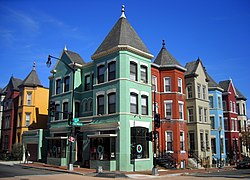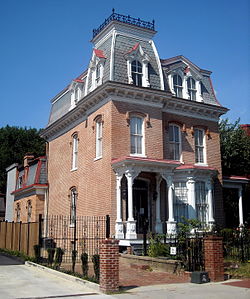LeDroit Park, Washington, D.C.
|
LeDroit Park Historic District
|
|

Intersection of 4th & T Streets, NW in LeDroit Park
|
|

Map of Washington, D.C., with Le Droit Park highlighted in red
|
|
| Location | Bounded roughly by Florida, Georgia, and Rhode Island Avenues, 2nd and Elm Streets, NW, Howard University, Washington, D.C. |
|---|---|
| Coordinates | 38°55′8.5872″N 77°1′1.326″W / 38.919052000°N 77.01703500°WCoordinates: 38°55′8.5872″N 77°1′1.326″W / 38.919052000°N 77.01703500°W |
| Built | 1873 |
| NRHP Reference # | 74002165 |
| Added to NRHP | February 25, 1974 |
 |
|
|
|
|
|
|
LeDroit Park (/ləˈdrɔɪt/ or /ˈliːdrɔɪt/) is a neighborhood in Washington, D.C. located immediately southeast of Howard University. Its borders include W Street to the north, Rhode Island Avenue and Florida Avenue to the south, Second Street NW to the east, and Howard University to the west. LeDroit Park is known for its history and 19th century protected architecture. The community's diversity entices new residents to the community, as well as its close proximity to the Shaw–Howard University Metro station and many dining options.
The neighborhood was founded in 1873 by Amzi Barber, a businessman who served on the board of trustees of neighboring Howard University. Barber named the neighborhood after his father-in-law, LeDroict Langdon, but dropped the ⟨c⟩.
As one of the first suburbs of Washington, LeDroit Park was developed and marketed as a "romantic" neighborhood with narrow tree-lined streets that bore the same names as the trees that shaded them, differing from the street names used in the rest of the city. Extensive focus was placed on the landscaping of this neighborhood, as developers spent a large sum of money to plant flower beds and trees to attract high-profile professionals from the city. Originally a whites-only neighborhood, LeDroit Park was even gated with guards to promote security for its residents. Efforts by many, especially multiple actions by students from Howard University, led to the integration of the area. In July 1888 students tore down the fences that separated the neighborhood in protest of its discriminating policies.
...
Wikipedia
